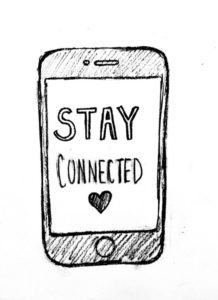Under our current state of affairs, building and maintaining connections is so vital for our mental health. For family members who may not be able to visit due to underlying health reasons, for kids who miss seeing their friends and who also thrive on interacting with their peers. Making connections is basic human need for all of us. Even our introverted friends! Our team of experts have put together some creative suggestions on how to embrace our new norm and to maintain those important connections.
Human beings are wired for social connection. Even the most introverted people crave connections. The continued need to social distance has made it challenging to find meaningful ways to connect with others, feel supported, and find comfort in social interaction. Although this is a global pandemic, not everyone is experiencing it in the same way and everyone has different levels of comfort with re-engaging with others.
 To find out how people were coping I decided to ask (via email, video conference, text, or phone call) “How are you finding ways to connect?” The following strategies appeared over and over again when parents, grandparents, children, and teachers replied to my question. Bring back the phone call – a lot of people these days prefer to text, however, respondents said the act of hearing someone’s voice made them feel closer. Bring back pen pals – write letters to a relative or friend. There is still something exciting about getting a letter in the mail. Use technology to your advantage – make video calls so you can see one another. So many services offer ways to connect online as well.
To find out how people were coping I decided to ask (via email, video conference, text, or phone call) “How are you finding ways to connect?” The following strategies appeared over and over again when parents, grandparents, children, and teachers replied to my question. Bring back the phone call – a lot of people these days prefer to text, however, respondents said the act of hearing someone’s voice made them feel closer. Bring back pen pals – write letters to a relative or friend. There is still something exciting about getting a letter in the mail. Use technology to your advantage – make video calls so you can see one another. So many services offer ways to connect online as well.
Netflix has watch parties where you and friends watch the same movie and can chat and comment throughout. You can do a lot of classes and activities online with family and friends as well – cooking, painting, dance, escape rooms etc. Chalk the Walk – put positive messages around the neighborhood when you go on a walk or visit a friend’s house and leave a special message on the driveway. Find ways to give – It’s the “Have You Filled A Bucket” principle that doing good for others does good for you too.
Providing for those in need, supporting the community, and protecting the environment provides a broader connection that is beneficial to your mental health and wellness. These are just a few suggestions from my friends, family, and colleagues. I’d love to hear if you have any other ideas!
With (virtual) school back in session, many students are missing out on the connection they had with their peers during the school day. There isn’t the opportunity to eat lunch together, talk with your table mates in the classroom, or even wave to a friend in the hallway.
I’ve been hearing a lot from the families I work with about the struggle of being able to see their friends but not having the opportunity to hang out and chat. Brainstorm with your children on some fun ways they might be able to spend time with their classmates. Set up a weekly online Uno tournament, find a pen pal, or schedule some after-school virtual play dates. Some may enjoy having virtual homework or study dates with their classmates or starting a book club about something they have learned about in class. Even though there is a need for physical distance it doesn’t mean we can’t find ways to stay social!
A critical component of the developmental period during adolescence is social connection. For most teens, the restrictions that have been put in place (for important public health measures) due to COVID-19 have presented themselves as a disruption to the social aspect of their developmental process. This may be especially detrimental for LGBTQ+ teens, particularly those that don’t feel ready to come out yet or don’t feel safe coming out to their families at all, as it leads to increased feelings of isolation and loneliness.
With that being said, the formation and maintenance of social connection has become more important than ever. So, in this time of physical distancing and remote learning, how can any adult in the life of an LGBTQ+ teen help with fostering a sense of connection during these challenging times?

Have you felt Socially DISCONNECTED? Is the pandemic causing you angst?
Join the club.
The isolation and social distancing has us all feeling “a certain kind of kind of way.” During this unprecedented time (which will pass) it is important to maintain a sense of wellbeing and stay connected. As we approach fall, here are a few things you and your family can do to CONNECT. And have fun, too:
Search. Find. Enjoy Be happy. Stay connected!
In the new age of living in a Pandemic, the word connection has taken on a whole different meaning. I take more walks with my family than ever before, and with this new habit has brought new connections. There is more time to stop and smell the roses with my two year old son, or talk to the sweet elderly couple sitting on their porch who miss seeing their grandkids. Before the Pandemic, I didn’t know the names of most of my neighbors, and now I have an active list going with my husband of all the people we chat with along our path.
In addition to these new connections, the Pandemic has also highlighted the importance of maintaining old friendships. I used to meet in person once a month for book club, and now it has switched to meeting virtually on Zoom. Although my book club was in existence before the Pandemic, forming a group in our current setting could be a great way to build and foster connection. This group can be with family, friends, or even fellow parents who you have not met in person.
Do not be afraid to make the plunge and meet new people in ways you may not have expected! Also remember the importance of reaching out when you need it!
Until next time, Be Wise!
“Oh my gosh, my daughter just thinks Grace is amazing and I am so glad that she has someone to talk to that isn’t me! She is so happy after her sessions! Thank you.”
— Mom of 15 year old client“I don’t think we could survive our kid without The Wise Family. Our clinician is so patient and such a compassionate person. She helps our child feel so in control of his body, and us so in control of our parenting.”
— Parent of 6 year old client“Supporting the mental health of the kids and teens in our community is one of the most challenging and also one of the most important jobs anyone could have. And I see your team doing it with both skill and enthusiasm.Our family could not be more fortunate to have found your practice 3 years ago.
Our kids are growing up but we still keep your number on our phone and we know we can reach out to your team if we need it. We tell everyone who asks about the WISE people at The Wise Family.
Thank you for doing what you do for so many people.”—from the parent of two former clients (siblings)
— Parent of two former clients (siblings)“Dr. Amy is like Oprah – she’s the neighbor you love who is very, very smart”
— Parent of 14-year-old son and 18-year-old daughter